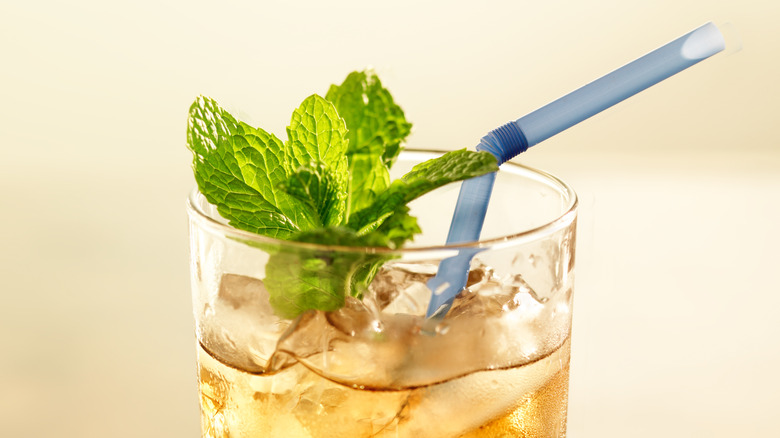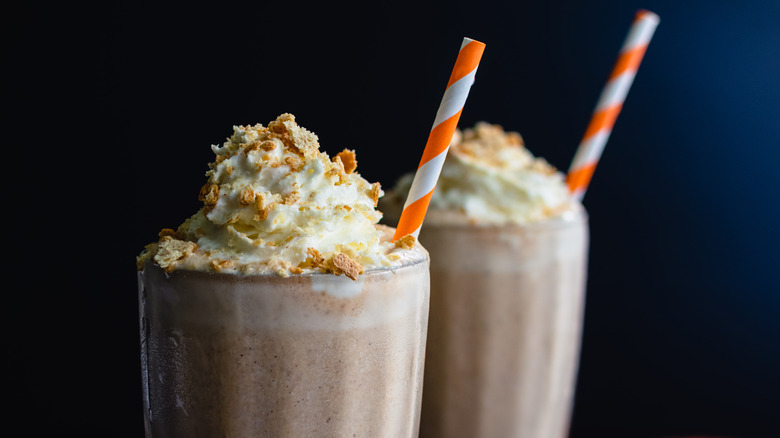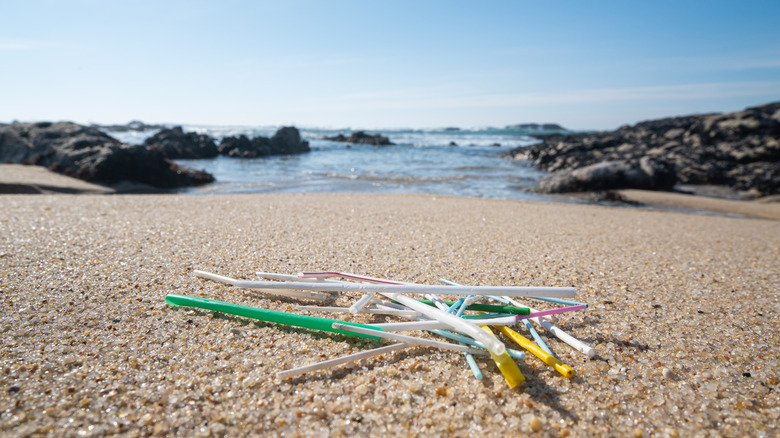Here's How The Bendy Straw Was Invented
One of the most ubiquitous kitchen utensils is often forgotten about — until someone needs to use it for a cool beverage. Made with just a few inches of plastic, a bendy drinking straw is a massively efficient tool that can act as a convenient sipping apparatus or merely an accessory for your glass. But how did straws originate? Where did the modern "bendy" variation come from? How has the straw industry been affected by recent changes in the eco-friendly space?
The straw's history is long and storied. According to The Atlantic, one of the earliest iterations of the tool was found in a lavish Sumerian tomb from 3,000 B.C. Argentinians are also known to have consumed beverages through a metal straw for hundreds of years. However, the term "straw" didn't come along until much later in the 1800s — when people began to use actual straw, grass, or hay to aid their drinking, as noted by Bon Appétit. Flimsy, gritty, and prone to adding an earthlike flavor to beverages, these natural materials weren't the best choice. Of course, the straw industry has changed a lot since then.
The straw was invented to make drinking easier
Alcohol Professor notes that ice was a reason behind the 19th-century invention of drinking straws. With a straw, the drinker wouldn't have to navigate around the cubes when enjoying their cool beverage. Furthermore, many men of the era had finely coiffed facial hair, which would "melt" into their drinks when they sipped. Fortunately for them, Marvin Stone invented one of the first industrially made straws in the late 1880s, using proper materials to keep the straw from breaking down or becoming soggy, per the Smithsonian Institution. This stick-straight invention was wildly popular in the early 1900s: The laborious act of tilting one's head back to drink from the mouth of a glass — halting a conversation at best or straining the neck at worst — was now a bygone issue. However, the rigid, long straw posed some unexpected drawbacks.
Enter Joseph Friedman's patented bendy straw of 1937. The story goes that Friedman noticed his young daughter struggling to drink a milkshake with a straight straw, which stuck out of the glass at a point too high for his small child to reach (via Smithsonian Magazine). With an inventive move using a screw and dental floss, he altered the straw to make it bend over the glass, and his daughter was able to drink seamlessly. This cleverness marked Friedman as the first person to create a straw that could bend and curve without preventing the movement of liquid. At the time, it was dubbed the "soda straw" and was used enthusiastically by soda fountain customers sipping on shakes and floats at high-up counters.
But will the bendy straw last?
In 1947, Friedman's Flex-Straw company got its first big order from a hospital — the beginning of a new era. An old ad saved by the Smithsonian Institution sings the praises of the "personalized drinking tube," which could bend to patients at any angle, save staff members' time (and therefore labor costs), and prevent the spread of germs. Smithsonian Magazine even notes that the bendy straw is acknowledged as a prime example of universal design, as it is an accessible tool that improves many users' quality of life. Over the following decades, the drinking straw helped reshape the modern American meal; Footprint links the invention's ties to the fast food boom of the 1950s and the world's embrace of plastic over paper.
By the 2010s, though, people began to be alarmed by the environmental impact of single-use plastics such as straws, which are a major contributor to marine waste. Celebrities, companies, and entire countries began banning plastic straws in favor of biodegradable versions. Amid these changes, it's easy to picture a world without plastic bendy straws in the near future. However, Alcohol Professor notes that a complete ban on plastic straws could pose an issue for those in the disabled community, some of whom rely on affordable plastic straws to consume liquids. Moreover, there are many allergies associated with certain ingredients in non-plastic straws.


